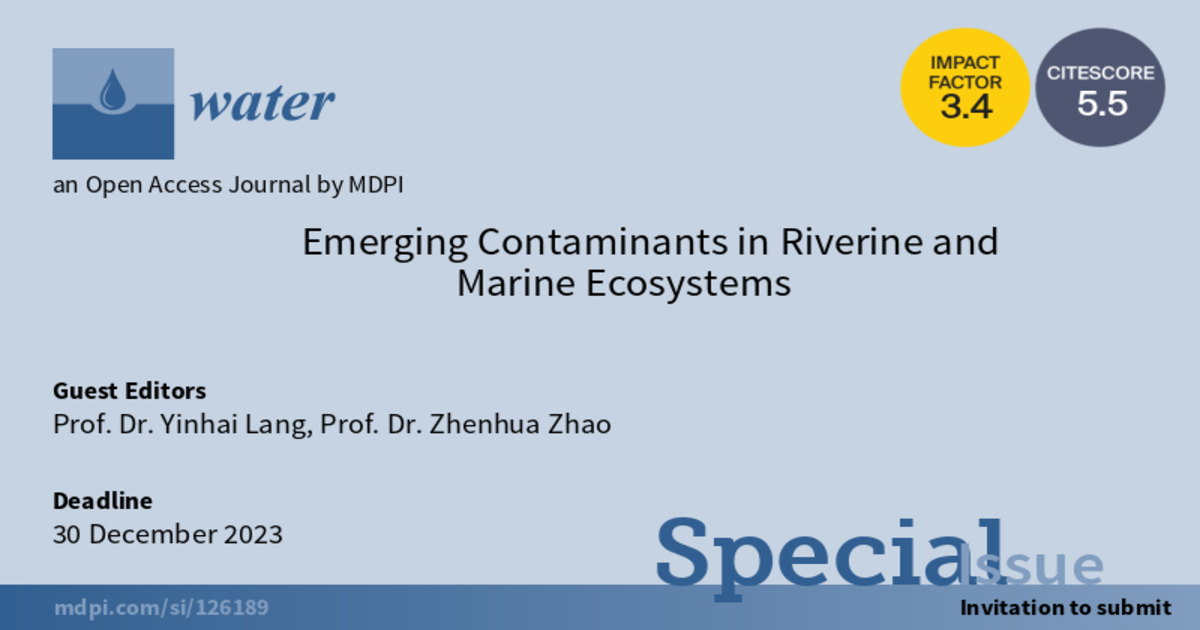- 3.0Impact Factor
- 6.0CiteScore
- 20 daysTime to First Decision
Emerging Contaminants in Riverine and Marine Ecosystems
This special issue belongs to the section “Water Quality and Contamination“.
Special Issue Information
Dear Colleagues,
Emerging contaminants (ECs) (endocrine-disrupting chemicals, pharmaceuticals and personal care products, pesticides, etc.) and superfluous nutrients have been receiving increased attention in the fields of riverine and marine ecosystems, as they pose serious threats to aquatic ecology and public health. Riverine and marine ecosystems receive diverse and complex contaminants from point and non-point sources, including industrial wastewater, municipal sewage discharge, and agricultural runoff. In contrast with terrestrial ecosytems, in riverine and marine ecosystems ECs and other contaminants generally have lower concentrations and higher mobility, thus are difficult to detect and assess, and harm aquatic environments. Given the serious negative effects of ECs and superfluous nutrients on riverine and marine ecosystems, green remediation strategies are expected to be developed.
This Special Issue welcomes critical reviews, monographs, mini research articles, and research papers concerning the occurrence, transportation, and risk assessment of ECs in riverine and marine ecosystems, their environmental effects on aquatic organisms (microbes, invertebrates, plants, fish, etc.), and sustainable and environmental friendly laboratory- and field-scale approaches and methods for remediating and mitigating ECs in riverine, estuarine and marine environments.
Prof. Dr. Yinhai Lang
Prof. Dr. Zhenhua Zhao
Guest Editors
Manuscript Submission Information
Manuscripts should be submitted online at www.mdpi.com by registering and logging in to this website. Once you are registered, click here to go to the submission form. Manuscripts can be submitted until the deadline. All submissions that pass pre-check are peer-reviewed. Accepted papers will be published continuously in the journal (as soon as accepted) and will be listed together on the special issue website. Research articles, review articles as well as short communications are invited. For planned papers, a title and short abstract (about 250 words) can be sent to the Editorial Office for assessment.
Submitted manuscripts should not have been published previously, nor be under consideration for publication elsewhere (except conference proceedings papers). All manuscripts are thoroughly refereed through a single-blind peer-review process. A guide for authors and other relevant information for submission of manuscripts is available on the Instructions for Authors page. Water is an international peer-reviewed open access semimonthly journal published by MDPI.
Please visit the Instructions for Authors page before submitting a manuscript. The Article Processing Charge (APC) for publication in this open access journal is 2600 CHF (Swiss Francs). Submitted papers should be well formatted and use good English. Authors may use MDPI's English editing service prior to publication or during author revisions.
Keywords
- emerging contaminants
- riverine and marine ecosystem
- source identification
- occurrence
- transportation
- ecological risk
- health risk
- contamination indices
- environmental toxicology
- remediation

Benefits of Publishing in a Special Issue
- Ease of navigation: Grouping papers by topic helps scholars navigate broad scope journals more efficiently.
- Greater discoverability: Special Issues support the reach and impact of scientific research. Articles in Special Issues are more discoverable and cited more frequently.
- Expansion of research network: Special Issues facilitate connections among authors, fostering scientific collaborations.
- External promotion: Articles in Special Issues are often promoted through the journal's social media, increasing their visibility.
- e-Book format: Special Issues with more than 10 articles can be published as dedicated e-books, ensuring wide and rapid dissemination.

